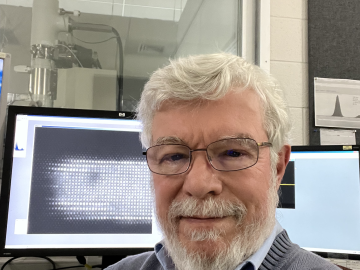
Filter News
Area of Research
- Advanced Manufacturing (9)
- Biology and Environment (32)
- Building Technologies (1)
- Computational Biology (1)
- Computational Engineering (1)
- Computer Science (9)
- Electricity and Smart Grid (1)
- Energy Science (37)
- Functional Materials for Energy (1)
- Fusion and Fission (1)
- Fusion Energy (1)
- Isotopes (1)
- Materials (37)
- Materials for Computing (4)
- National Security (16)
- Neutron Science (11)
- Nuclear Science and Technology (1)
- Quantum information Science (3)
- Supercomputing (55)
News Topics
- (-) 3-D Printing/Advanced Manufacturing (32)
- (-) Artificial Intelligence (27)
- (-) Biology (29)
- (-) Computer Science (69)
- (-) Exascale Computing (10)
- (-) Irradiation (1)
- (-) Machine Learning (15)
- (-) Microscopy (23)
- (-) Quantum Science (22)
- Advanced Reactors (12)
- Big Data (17)
- Bioenergy (30)
- Biomedical (16)
- Biotechnology (4)
- Buildings (16)
- Chemical Sciences (15)
- Clean Water (11)
- Composites (8)
- Coronavirus (9)
- Critical Materials (5)
- Cybersecurity (15)
- Element Discovery (1)
- Energy Storage (35)
- Environment (58)
- Fossil Energy (1)
- Frontier (12)
- Fusion (16)
- Grid (21)
- High-Performance Computing (16)
- Hydropower (8)
- Isotopes (11)
- ITER (2)
- Materials (37)
- Materials Science (46)
- Mercury (3)
- Molten Salt (5)
- Nanotechnology (24)
- National Security (17)
- Neutron Science (43)
- Nuclear Energy (37)
- Partnerships (8)
- Physics (25)
- Polymers (12)
- Quantum Computing (7)
- Security (13)
- Simulation (6)
- Space Exploration (10)
- Summit (18)
- Transportation (29)
Media Contacts

Researchers at ORNL have developed an online tool that offers industrial plants an easier way to track and download information about their energy footprint and carbon emissions.
A team from Oak Ridge National Laboratory, Duke University and other institutions studying Sphagnum moss have identified two new species in North America, and they are learning how evolution may affect the species’ role in carbon storage.

Two years after ORNL provided a model of nearly every building in America, commercial partners are using the tool for tasks ranging from designing energy-efficient buildings and cities to linking energy efficiency to real estate value and risk.

A new paper published in Nature Communications adds further evidence to the bradykinin storm theory of COVID-19’s viral pathogenesis — a theory that was posited two years ago by a team of researchers at the Department of Energy’s Oak Ridge National Laboratory.

A multi-lab research team led by ORNL's Paul Kent is developing a computer application called QMCPACK to enable precise and reliable predictions of the fundamental properties of materials critical in energy research.

Five technologies invented by scientists at the Department of Energy’s Oak Ridge National Laboratory have been selected for targeted investment through ORNL’s Technology Innovation Program.

Five National Quantum Information Science Research Centers are leveraging the behavior of nature at the smallest scales to develop technologies for science’s most complex problems.

Researchers at the Department of Energy’s Oak Ridge National Laboratory and their technologies have received seven 2022 R&D 100 Awards, plus special recognition for a battery-related green technology product.

Scientists at ORNL have created a miniaturized environment to study the ecosystem around poplar tree roots for insights into plant health and soil carbon sequestration.

Larry Allard, a distinguished research staff member at Oak Ridge National Laboratory, has been named a Fellow of the Microanalysis Society.


